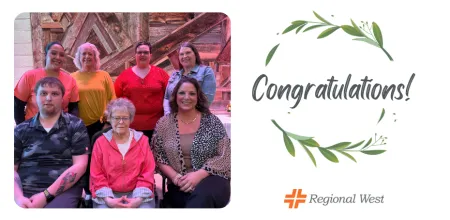Hornstein Finds Passion for Patient Care in Nuclear Medicine

For Vanessa Hornstein, CNMT, a technologist in Regional West’s Nuclear Medicine department, her job allows her to give patients peace of mind while helping them find sought-after answers.
“It’s so rewarding to bring peace to my patients and help give them tools they can use for their treatment,” she said.
Hornstein’s love for nuclear medicine started in high school when she toured Banner Health’s Nuclear Medicine department in Phoenix, Arizona, her hometown. She stayed in Phoenix and graduated with a nuclear medicine degree from GateWay Community College. In May, Hornstein celebrated 10 years in the specialty.
“In my experience, nuclear medicine teams are usually small and close-knit,” she said. “It’s just myself and my teammate Rachel. She’s been phenomenal, and we have a good team atmosphere.”
Since starting in January, Hornstein has enjoyed Regional West’s welcoming atmosphere. She recalled a time when she was lost during new hire orientation and an employee walked her across the hospital to help her find her car.
“I’ve been welcomed with open arms. Everyone is so nice, and it’s really a breath of fresh air,” she said.
Compared to CT imaging, nuclear medicine works in reverse. Instead of using cameras with radiation, patients receive a radioactive isotope, usually through IV injection, that allows cameras to detect radiation within the patient’s body. Nuclear medicine can help diagnose and treat numerous conditions such as heart disease, thyroid issues, and cancer.
Hornstein says nuclear medicine gives patients answers that other specialties cannot. MRI, X-ray, and CT imaging can assess anatomy, but nuclear medicine imaging can determine how organs and tissues are functioning. She said she loves being part of the problem-solving process.
“We provide an extra piece of the puzzle and help give patients a better idea of what’s going on. It gives them a roadmap for treatment, and it’s very rewarding to be part of that.”
Hornstein has a special place in her heart for oncology and neurology patients. In the midst of an often-scary time, she enjoys being a source of comfort and motivation.
“When someone is diagnosed with cancer or another life-altering illness, it can feel like a runaway car. It can be very emotional, but I try to help give people a sense of control back. My patients may only be with me for an hour and a half, but I can help them see that they are driving the car, and they can make it through.”








